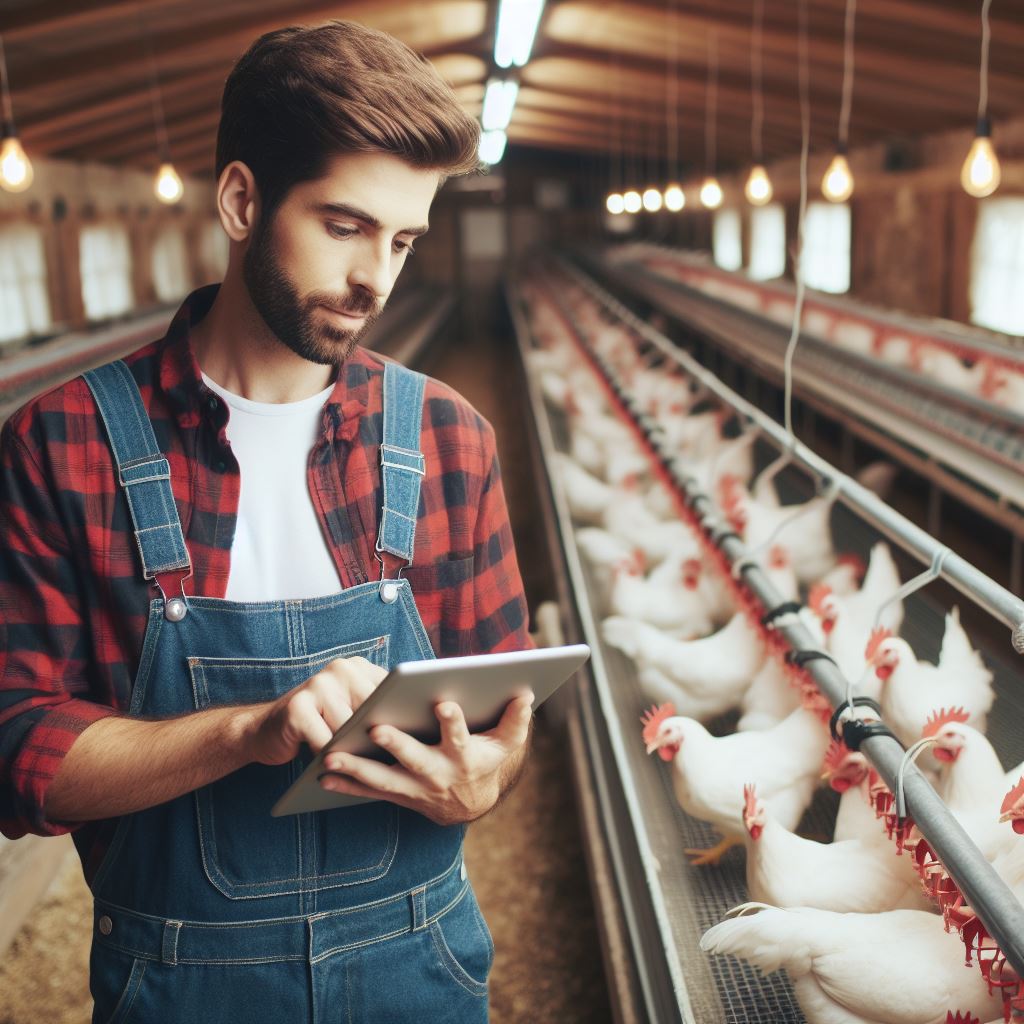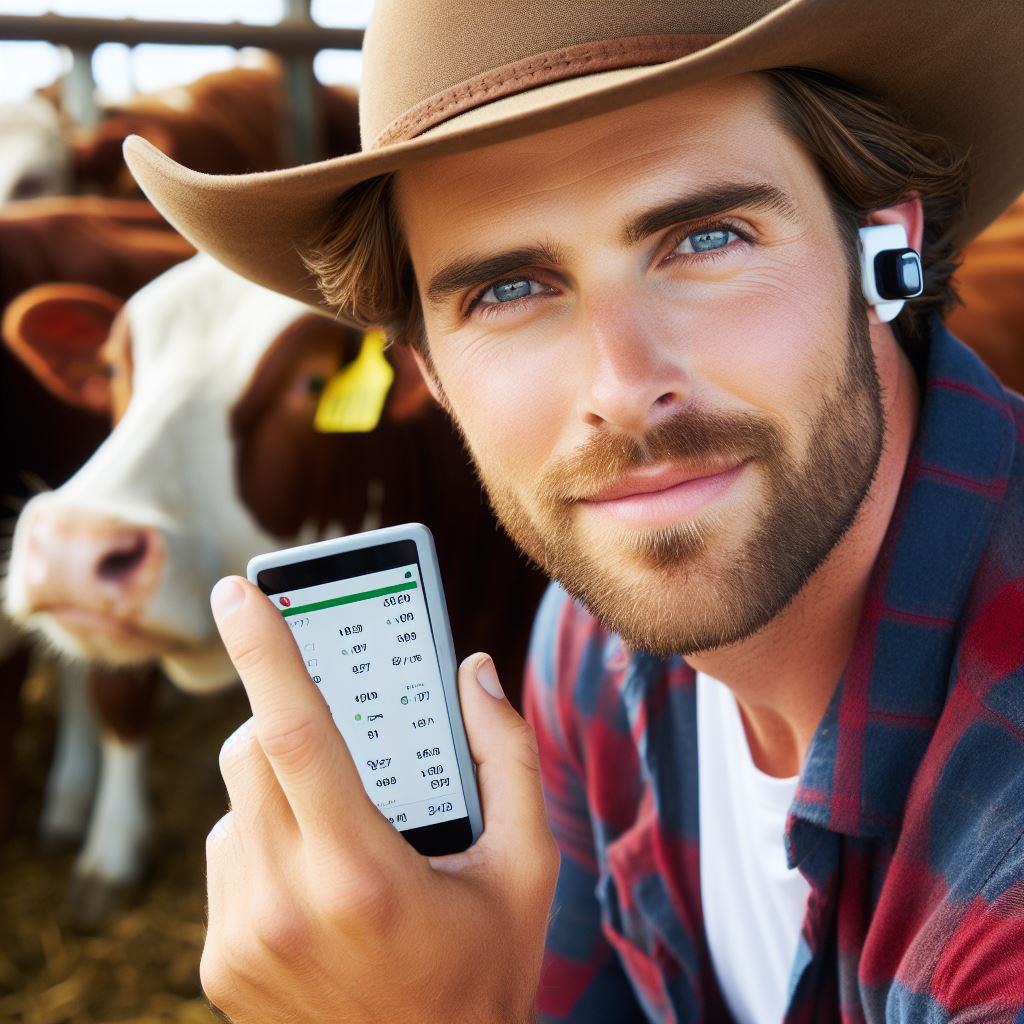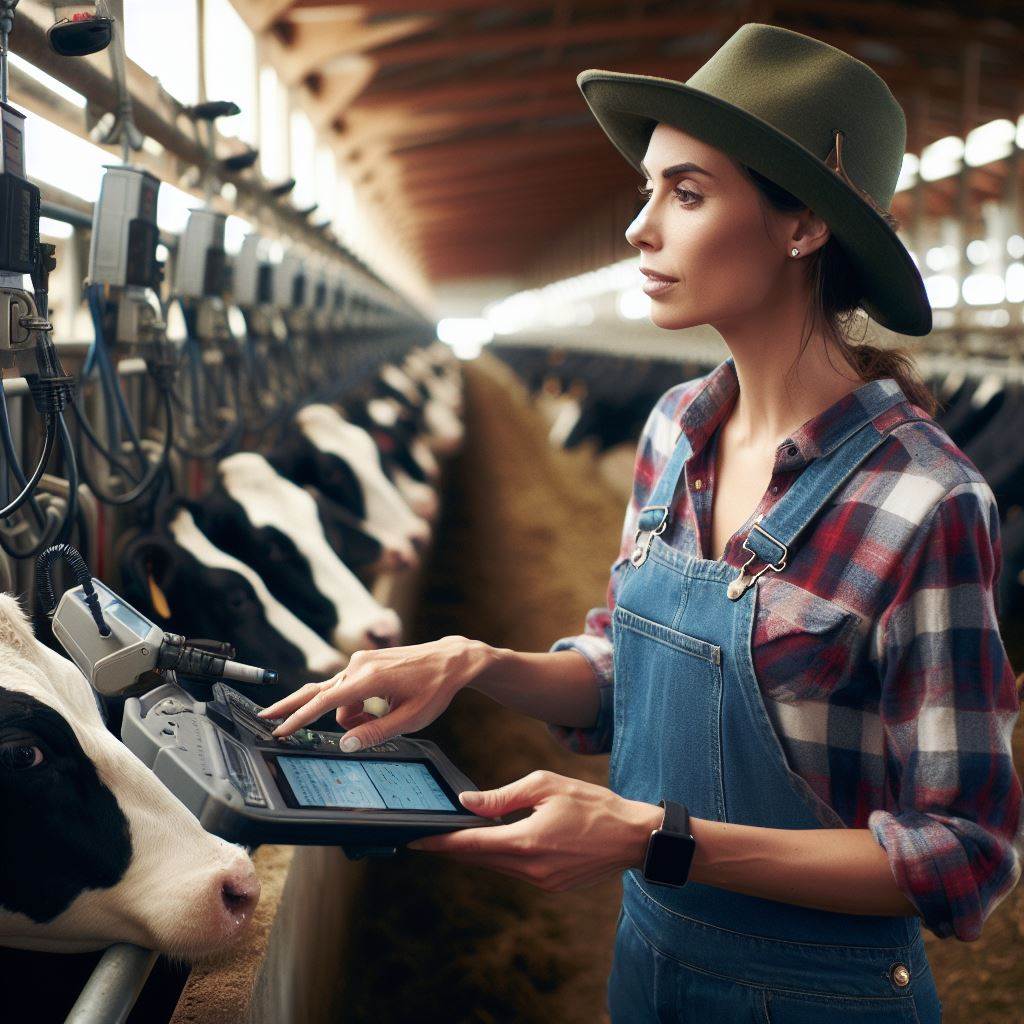Introduction
Importance of technology in the poultry industry
Technology plays a vital role in the ever-evolving poultry industry, revolutionizing traditional practices.
In this blog post, we will explore the latest innovations unveiled in the field of poultry farming.
As the demand for poultry products continues to rise, farmers are turning to technology to improve efficiency and productivity.
From automated feeding and watering systems to advanced data analytics, technology offers numerous benefits.
Overview of the blog post
This blog post will discuss groundbreaking innovations in the poultry industry.
We will delve into the development of smart sensors that monitor temperature, humidity, and other crucial factors, ensuring optimal conditions for the birds.
Moreover, we will explore the implementation of artificial intelligence and machine learning algorithms in poultry farming.
These technologies enable farmers to analyze data, predict disease outbreaks, and optimize flock management.
Another exciting development is the use of drones in monitoring and managing poultry farms.
Drones equipped with cameras and sensors can inspect barns, identify diseased birds, and make informed decisions based on real-time data.
Furthermore, genetic engineering and biotechnology have played a significant role in improving poultry breeding and disease resistance.
Through selective breeding and genetic modification, scientists have developed healthier and more resilient chicken breeds.
Basically, this blog post highlights the importance of technology in the poultry industry.
The innovations discussed here have the potential to revolutionize poultry farming, improving efficiency, animal welfare, and overall productivity.
Stay tuned to learn more about how technology continues to shape the future of poultry farming.
Transform Your Agribusiness
Unlock your farm's potential with expert advice tailored to your needs. Get actionable steps that drive real results.
Get StartedBenefits of Tech Innovations in Poultry Farming
In today’s modern world, technology has become an integral part of various industries, and poultry farming is no exception.
The introduction of innovative technologies in this sector has revolutionized the way chickens are raised and managed.
These advancements bring numerous benefits, including:
Improved efficiency and productivity
- Automated feeding and watering systems ensure a constant supply of food and water, eliminating manual labor.
- Smart sensors and data analytics provide valuable insights, allowing farmers to optimize production processes and achieve higher yields.
- Poultry management software simplifies record-keeping and helps farmers make data-driven decisions.
By incorporating these technologies, poultry farmers can streamline operations and maximize their output, leading to increased efficiency and productivity.
Enhanced animal welfare and health monitoring
- Real-time monitoring systems enable continuous tracking of chicken behavior, health parameters, and environmental conditions.
- Smart cameras and sensors detect any signs of distress or disease, enabling prompt intervention and preventing widespread outbreaks.
- Automated ventilation and temperature control systems ensure optimal living conditions for the chickens, improving their overall welfare.
With these innovations, farmers can closely monitor and maintain the well-being of their poultry, resulting in healthier flocks and improved animal welfare standards.
Cost-saving measures
- Automated egg collection systems reduce labor costs associated with manual collection.
- Efficient heating and cooling systems optimize energy usage, lowering electricity expenses.
- Precision feeding systems minimize waste by providing the right amount of feed to each chicken, reducing feed costs.
By implementing cost-saving measures through technology, poultry farmers can enhance their profitability and sustain their business in a competitive market.
Environmental sustainability
- Advanced waste management systems convert poultry waste into bioenergy or organic fertilizers, reducing environmental impact.
- Water recycling and conservation technologies minimize water usage, addressing concerns related to water scarcity.
- Smart lighting systems mimic natural day and night cycles, promoting energy efficiency and reducing carbon footprint.
By embracing eco-friendly technologies, poultry farming can become more sustainable, reducing its ecological footprint and contributing to environmental preservation.
Generally, the integration of technology in poultry farming brings a plethora of benefits.
Improved efficiency and productivity, enhanced animal welfare and health monitoring, various cost-saving measures, and environmental sustainability are just some of the advantages that these innovations provide.
As the world continues to advance, it is crucial for poultry farmers to embrace these technological advancements to thrive in today’s competitive market while ensuring the well-being of their poultry and the preservation of our planet.
Read: Tech in Poultry: Innovations Unveiled
Automated Systems for Poultry Management
In the quest to increase efficiency and productivity, the poultry industry has embraced automation as a game-changer.
By automating various aspects of poultry management, farmers are able to save time, reduce labor costs, and improve overall operations.
Automated Feeding and Watering Systems
Gone are the days when farmers had to manually feed and water each bird in their poultry house.
Automated feeding and watering systems have revolutionized poultry management by ensuring that birds have access to food and water at all times.
These systems consist of feeders and waterers that are connected to a central control panel.
The panel can be programmed to release a predetermined amount of feed and water based on the specific needs of the birds.
This eliminates the need for constant monitoring and manual intervention.
Not only do automated feeding and watering systems save time and labor, but they also promote uniformity in bird growth and reduce the risk of disease transmission through contaminated water or feed.
Ventilation and Climate Control Technology
Proper ventilation and climate control are crucial for maintaining a healthy and comfortable environment inside poultry houses.
With the advent of automated ventilation and climate control technology, farmers can now achieve optimal conditions without manual intervention.
These systems utilize sensors to monitor temperature, humidity, and air quality inside the poultry house.
Based on the readings, the system automatically adjusts the ventilation and climate control parameters to ensure optimal conditions.
Automated ventilation and climate control technology not only benefits the birds by providing them with a comfortable living environment but also helps to minimize the risk of respiratory diseases and heat stress.
Showcase Your Farming Business
Publish your professional farming services profile on our blog for a one-time fee of $200 and reach a dedicated audience of farmers and agribusiness owners.
Publish Your ProfileIt also helps to prevent excessive moisture buildup, which can lead to issues like mold and ammonia production.
Egg Collection and Sorting Machines
For poultry farms that focus on egg production, automated egg collection and sorting machines have proven to be indispensable tools.
These machines eliminate the need for manual collection and sorting of eggs, saving time and reducing the risk of damage.
Egg collection machines are equipped with conveyor belts that transport eggs from the nesting area to a centralized collection point.
The eggs are then sorted based on parameters like weight, color, and quality.
These machines not only improve efficiency in egg collection but also help to minimize the risk of cracked or dirty eggs reaching consumers.
Additionally, they enable farmers to accurately track egg production and identify potential issues.
The use of automated systems in poultry management has revolutionized the industry, making it more efficient, productive, and sustainable.
Automated feeding and watering systems, ventilation and climate control technology, and egg collection and sorting machines have transformed the way farmers operate.
By embracing these technological advancements, poultry farmers can focus on other crucial aspects of their business, such as disease prevention and flock management.
As technology continues to evolve, it is likely that we will witness even more innovative solutions that further enhance poultry management.
Read: Sensor Tech in Livestock Care: An Insight
Advanced Genetic Selection and Breeding Techniques
In the quest for improving poultry production, farmers and researchers have turned to advanced genetic selection and breeding techniques.
By harnessing genetic information, they aim to enhance disease resistance, meat quality, and egg production.
Use of genetic information for disease resistance
One significant application of advanced genetic techniques in poultry is using genetic information to develop disease-resistant breeds.
By identifying specific genes associated with resistance to common poultry diseases, breeders can selectively breed birds with enhanced immunity.
This approach not only reduces the risk of disease outbreaks but also minimizes the need for antibiotics and other medications.
By reducing the use of these substances, farmers can produce healthier and safer poultry products for consumers.
Breeding for better meat quality and egg production
Another area where advanced genetic selection and breeding techniques are making strides is in improving meat quality and egg production.
By selectively breeding chickens with desirable traits, such as larger breast muscles or higher egg-laying rates, farmers can enhance the overall productivity of their flocks.
For example, genetic markers associated with meat tenderness or egg size can be identified and used to breed chickens with superior attributes.
This results in poultry products that meet consumer preferences for taste, texture, and overall quality.
Role of artificial insemination in improving genetics
Artificial insemination (AI) is a technique that plays a vital role in improving poultry genetics.
By collecting semen from superior males and inseminating it into multiple females, farmers can ensure that the genetic traits of exceptional individuals are passed on to future generations.
AI helps overcome the limitations of natural mating, allowing breeders to control and optimize the genetic makeup of their flocks.
This technique enables the propagation of desirable traits and facilitates the production of genetically superior poultry.
Moreover, AI enables breeders to preserve rare or endangered poultry breeds by effectively managing their genetic diversity.
This ensures the long-term survival and conservation of unique genetic resources.
Generally, advanced genetic selection and breeding techniques offer tremendous potential for the poultry industry.
By utilizing genetic information, breeders can develop disease-resistant breeds, enhance meat quality and egg production, and optimize the genetic diversity of their flocks through artificial insemination.
These innovations are driving the industry towards more sustainable and efficient poultry production practices, ultimately benefiting both producers and consumers.
Read: Livestock Drones: Changing Farming Dynamics
Precision Farming and Data Analysis
Poultry farming has evolved significantly in recent years, thanks to advancements in technology.
One area where technology has made a significant impact is precision farming and data analysis.
By implementing monitoring systems, data-driven decision making, and geospatial technology, farmers can enhance bird performance and improve flock management.
Let’s explore these innovations in more detail.
Monitoring systems for individual bird performance
Traditional farming practices often treated flocks as a collective unit, neglecting individual bird performance.
However, with the advent of monitoring systems, farmers can now track the health and behavior of each bird.
These systems use various sensors, such as motion detectors and temperature sensors, to capture real-time data on individual bird activity.
This data can help identify potential health issues, such as diseases or injuries, at an early stage, ensuring timely intervention.
Showcase Your Farming Business
Publish your professional farming services profile on our blog for a one-time fee of $200 and reach a dedicated audience of farmers and agribusiness owners.
Publish Your ProfileData-driven decision making for flock management
Gone are the days when farmers relied solely on their experience and intuition to make decisions about flock management.
Nowadays, data analysis plays a crucial role in making informed decisions.
By collecting and analyzing data on factors such as feed intake, weight gain, and environmental conditions, farmers can optimize their flock management strategies.
This data-driven approach enables farmers to identify trends, spot anomalies, and adjust management practices accordingly, ultimately improving flock performance and profitability.
Application of geospatial technology in poultry farming
Geospatial technology, including Global Positioning System (GPS) and Geographic Information System (GIS), has revolutionized how farmers manage their poultry farms.
By integrating these technologies, farmers can obtain precise information about their farms’ layout, topography, and infrastructure.
This information is vital for efficient resource allocation, such as determining the optimal placement of feeders and water systems.
Moreover, geospatial technology allows farmers to closely monitor the environmental impact of their operations, helping them comply with sustainable farming practices.
Benefits beyond individual farmers
The benefits of these innovations extend beyond individual farmers.
The poultry industry as a whole can benefit from the insights gained through precision farming and data analysis.
By sharing anonymized and aggregated data with researchers and industry experts, farmers contribute to the collective knowledge of best practices.
This collaborative approach enables the development of innovative solutions that benefit the entire industry, leading to improved animal welfare, increased productivity, and reduced environmental impacts.
Challenges that come with implementing precision farming and data analysis
However, implementing precision farming and data analysis does come with challenges.
Farmers must invest in the necessary infrastructure, such as monitoring systems and data collection tools, which can be costly.
Additionally, managing and analyzing large volumes of data requires skilled personnel and robust data management systems.
Farmers must invest in training and hiring professionals with expertise in data analysis to fully leverage the potential of these innovations.
Essentially, precision farming and data analysis have revolutionized poultry farming.
With monitoring systems, farmers can track individual bird performance, leading to improved health management.
Data-driven decision making optimizes flock management practices, enhancing overall performance and profitability.
Integrating geospatial technology allows precise resource allocation and environmental monitoring.
By embracing these innovations, the poultry industry can achieve sustainable growth and contribute to the advancement of animal agriculture as a whole.
Read: Sustainable Livestock Farming Technologies

Emerging Technologies in Poultry Care
In recent years, the poultry industry has seen a surge in the development and application of groundbreaking technologies to enhance the care and management of poultry farms.
These emerging innovations offer numerous advantages in terms of efficiency, disease detection, and training.
Use of Robotics for Cleaning and Maintenance
One of the key advancements in poultry farming is the utilization of robotics for cleaning and maintenance tasks.
Robots equipped with specialized tools and sensors can efficiently clean pens, remove waste, and even perform routine maintenance tasks.
These robotic systems not only reduce the burden on farmers but also ensure consistent and thorough cleaning, which is vital for maintaining optimal hygiene in the poultry farm.
Additionally, robotics minimize human labor costs and reduce the risk of injury associated with manual cleaning.
AI-powered Monitoring and Disease Detection
Artificial Intelligence (AI) has revolutionized various industries, and the poultry sector is no exception.
AI-powered monitoring systems have been developed to continuously track and analyze data from poultry farms, enabling early disease detection and prevention.
Through the use of sensors and computer vision technology, AI algorithms can detect subtle changes in poultry behavior, temperature, or feed consumption patterns, indicating the presence of a potential disease outbreak.
This timely detection allows farmers to take immediate action to prevent the spread of diseases and minimize economic losses.
Application of Virtual Reality in Poultry Training and Education
Virtual Reality (VR) has significantly expanded its reach beyond just gaming and entertainment.
In the poultry industry, VR is being used for training and education purposes, providing a highly immersive and realistic learning experience.
Poultry farmers and workers can enter a virtual environment that replicates a poultry farm, allowing them to practice various tasks, such as handling poultry, identifying diseases, and implementing biosecurity measures.
This technology enhances training efficiency, eliminates the need for physical setups, and reduces the risk of accidents during training sessions.
Furthermore, VR enables trainees to understand and visualize complex concepts related to poultry care, such as animal behavior analysis or ventilation system management, in a more interactive and engaging manner.
In short, the emergence of new technologies in poultry care brings forth a multitude of benefits for farmers, workers, and the entire industry.
Robotics for cleaning and maintenance streamline farm operations, AI-powered monitoring ensures early disease detection, and VR enhances training efficiency and safety.
By embracing these innovations, poultry farms can improve their productivity, reduce costs, and ensure the well-being of their birds.
Showcase Your Farming Business
Publish your professional farming services profile on our blog for a one-time fee of $200 and reach a dedicated audience of farmers and agribusiness owners.
Publish Your ProfileAs technology continues to evolve, it is crucial for the poultry industry to stay open to advancements that can further enhance the welfare and efficiency of poultry care.
Gain More Insights: Solar Power in Farms: A Green Revolution
Challenges and Concerns in Adopting Tech Innovations
In the rapidly evolving world of poultry farming, implementing new technologies brings along its own set of challenges and concerns.
While these innovations promise greater efficiency and productivity, certain obstacles need to be addressed before widespread adoption becomes a reality.
Cost and affordability of advanced technologies
- Farmers often face financial barriers when considering the adoption of tech innovations.
- The initial costs associated with purchasing and implementing advanced technologies can be substantial.
- Many small-scale farmers struggle to afford these investments, limiting their access to the benefits.
- Efforts should be made to make these technologies more affordable and accessible to farmers of all scales.
Training and skill development for farm operators
- Successful implementation of tech innovations requires proper training and skill development for farm operators.
- Learning to operate complex machinery and software can be challenging, especially for those with limited tech literacy.
- Investing in comprehensive training programs ensures farmers can effectively utilize the new technologies.
- Government and industry bodies can collaborate to provide ongoing support and educational resources for farm operators.
Potential ethical and welfare issues
- Introducing technology into poultry farming raises concerns regarding the ethical treatment and welfare of the animals.
- Automated systems may prioritize efficiency and productivity at the expense of animal well-being.
- Care must be taken to ensure that advancements do not compromise the health or comfort of the poultry.
- Regulations and guidelines should be implemented to safeguard the ethical treatment of animals within tech-driven systems.
In general, while the application of technology in poultry farming holds great promise, there are significant challenges and concerns that must be addressed.
The cost and affordability of advanced technologies need to be tackled to ensure equitable access for all farmers.
Additionally, providing adequate training and skill development opportunities will empower farm operators to make the most of these innovations.
Finally, ethical considerations and animal welfare must never be compromised, and regulations should be in place to ensure responsible implementation of tech-driven systems.
By actively addressing these challenges, the poultry industry can fully embrace and benefit from the potential of technology.
See Related Content: Drones in Farms: Changing the Agri Landscape
Future Outlook: Tech Trends in the Poultry Industry
With the continuous advancements in technology and the increasing demands for efficient and sustainable poultry production, there are several tech trends that are expected to shape the future of the industry.
These trends include the use of artificial intelligence and machine learning, blockchain technology for traceability, and precision medicine approaches for flock health.
Artificial intelligence and machine learning
Artificial intelligence (AI) and machine learning (ML) have already made significant contributions to various industries, and the poultry industry is no exception.
AI and ML can be used to collect and analyze large amounts of data, allowing farmers to make data-driven decisions and optimize poultry production processes.
By utilizing AI and ML, farmers can monitor bird behavior, predict disease outbreaks, and improve overall flock management.
Blockchain technology for traceability
Blockchain technology, known for its decentralization and transparency, has the potential to revolutionize traceability in the poultry industry.
With blockchain, every stage of the poultry production process can be recorded and verified, ensuring that the products are authentic and safe for consumption.
Consumers can access information about the poultry’s origin, feed, and any treatments it received, promoting trust and transparency.
Precision medicine approaches for flock health
Precision medicine approaches, which focus on tailoring medical treatments to individual patients, can also be applied to the poultry industry.
By analyzing genetic data, farmers can identify birds that are more susceptible to certain diseases or have advantageous traits.
This allows farmers to implement targeted treatments, reducing the need for antibiotics and promoting better flock health.
In addition to these specific tech trends, there are also broader advancements in automation, robotics, and data analytics that will continue to shape the future of the poultry industry.
Automation and robotics can streamline labor-intensive tasks, such as egg collection and cleaning, while data analytics can provide valuable insights for improving efficiency and productivity.
The future outlook for the poultry industry is promising, with these tech trends expected to enhance productivity, sustainability, and animal welfare.
However, there are also challenges that need to be addressed, such as the cost of implementing these technologies, ensuring data security, and the potential impact on employment in the industry.
Adoption is essential
Despite these challenges, the adoption of these tech trends in the poultry industry is essential for meeting the growing demand for poultry products while minimizing environmental impact.
These technologies can help farmers produce more with fewer resources, reduce the use of antibiotics, and ensure the safety and quality of poultry products.
Furthermore, the application of these tech trends can also improve animal welfare by enabling farmers to monitor and manage the health and well-being of their flocks more effectively.
Early detection of diseases, proactive treatment, and targeted interventions can contribute to better overall flock health and minimize the need for aggressive disease control measures.
In essence, the future of the poultry industry is poised for significant advancements driven by technology.
Artificial intelligence, blockchain technology, and precision medicine approaches are just a few of the many tech trends that will shape the industry’s future.
Adoption of these trends will not only improve operational efficiency and traceability but also contribute to sustainable and responsible poultry production.
Conclusion
Recap of the importance of tech innovations in poultry farming
Tech innovations in poultry farming have proven to be crucial in improving efficiency and profitability.
These advancements have greatly benefited the industry by enhancing disease detection and prevention, optimizing feed and water management, and increasing automation in various processes.
The importance of embracing technology in poultry farming cannot be overstated.
It enables farmers to monitor and control their operations effectively, resulting in healthier and more productive flocks.
Additionally, it provides opportunities for sustainable and environmentally friendly practices, which are essential in the face of global challenges such as climate change and food security.
Encouragement for further research and adoption of technology in the industry
It is encouraging to see the progress made in this field and the increasing interest in further research and adoption of technology in the industry.
Continuous exploration and investment in cutting-edge solutions will pave the way for even more innovative and efficient methods of poultry farming.
Farmers, researchers, and industry stakeholders must collaborate and share knowledge to ensure the widespread adoption of these advancements.
Showcase Your Farming Business
Publish your professional farming services profile on our blog for a one-time fee of $200 and reach a dedicated audience of farmers and agribusiness owners.
Publish Your ProfileThis will not only benefit individual farms but contribute to the overall growth and sustainability of the poultry industry.
In a nutshell, embracing tech innovations in poultry farming is vital for the industry’s future success.
The possibilities and benefits are vast, and it is an exciting time for those involved in this field.
As we move forward, let us continue to explore, invest, and implement these technologies to drive further progress and meet the growing demand for quality poultry products.



